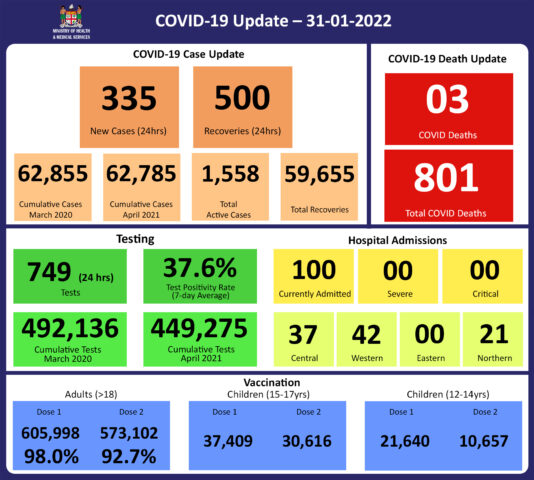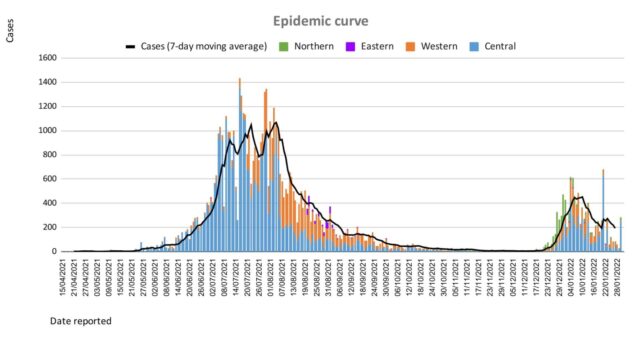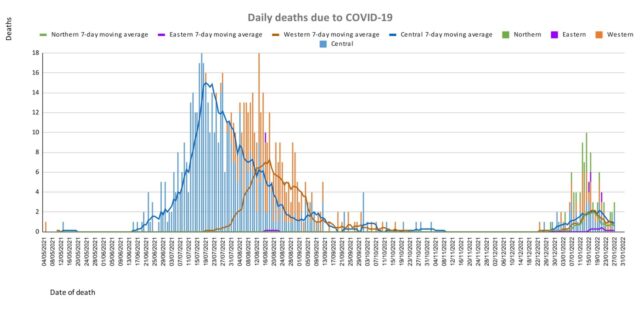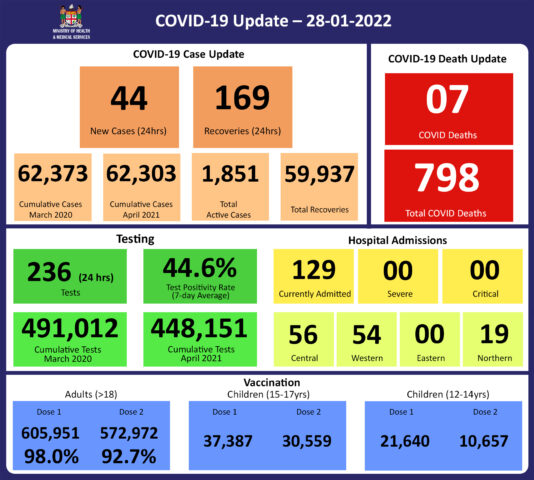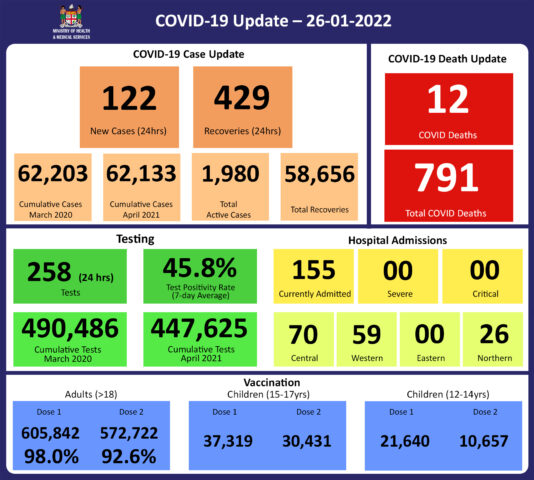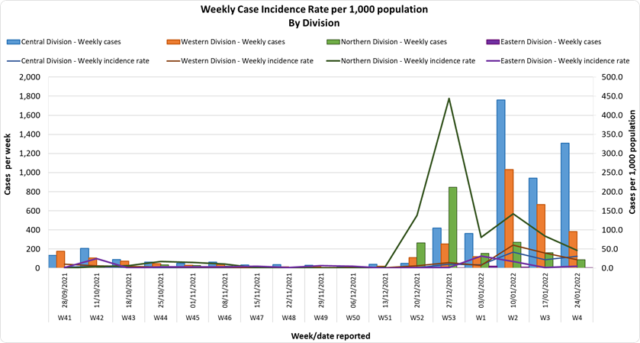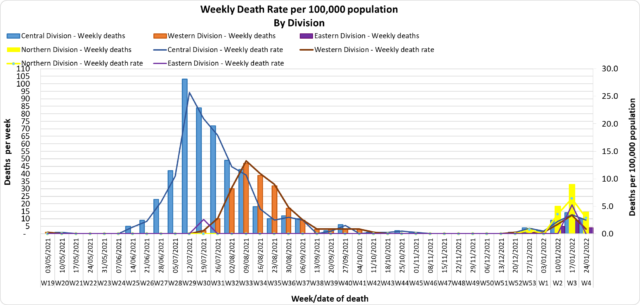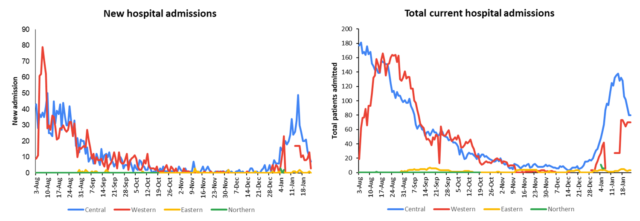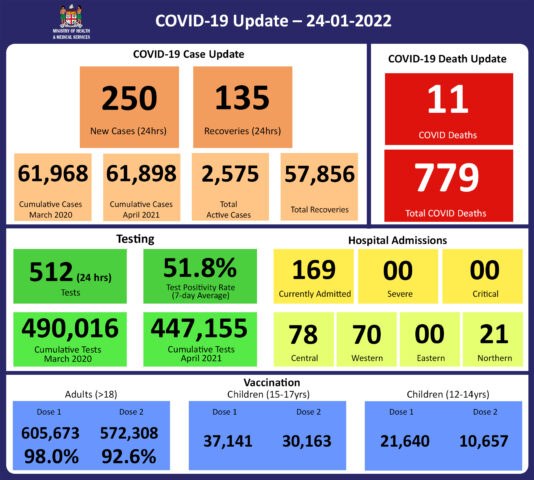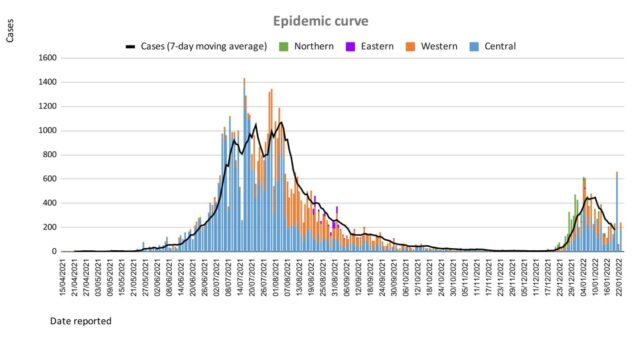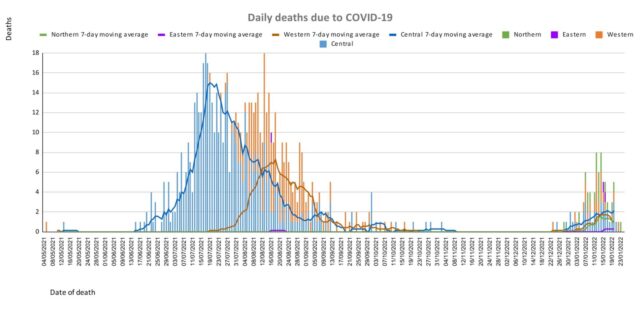Friday, 28th January 2022
Bula Vinaka and good afternoon.
Our data show that we are through the worst of this third wave. Our employers can also vouch for this given the decreasing of COVID-related absences from work. All that said, our COVID-safe measures must continue in the near term to protect those most vulnerable.
We have seen relatively low rates of hospitalisations and deaths in this wave due to our high rate of vaccination and have not had to create any extra space in our treatment facilities or mortuaries. But among the fatalities we have recorded, there is a clear trend: Most are unvaccinated, suffer from serious comorbidity, and die while at home.
This trend tells us that the next stage of our response involves a more holistic view of the medical realities the nation faces. I know that we’ve all grown accustomed to my updating the nation on the latest COVID-19 case numbers and response measures, but the focus of my brief today is on a group of diseases that not only can worsen COVID-19, but that inflict a far higher toll on our society than the virus ever could. I’m speaking of the prevalence of non-communicable diseases in Fiji — what we call, NCDs.
After nearly two years of non-stop COVID-19 coverage, I fear that this issue — which is by far and away from the number one killer of our people — has become secondary in our national discourse. But the suffering it creates is not second to any threat our people face to their wellbeing. The doctors and nurses I lead see the brutal face of this epidemic every day. We know it is a burden that has persisted long before COVID, in fact long before I became a doctor, and it demands our urgent attention as part of our resilience-building in a COVID-endemic world.
So, today, I am calling for a national reset for our national discourse on the health of our people. We need a new focus, from the media and members of the public, on what is most deadly and that is the epidemic of NCDs in this country.
Last week, our Ministry of Health and Medical Services Wellness Unit and Diabetes Fiji published NCD-related statistics from 2020. In a year dominated by almost nothing but COVID-19 headlines, we lost an estimated 5,700 Fijians due to NCD-related causes. These lives were ended too soon by quiet killers like diabetes, stroke, heart disease, and others.
I was glad to see some coverage this week of that staggering statistic. But we can’t settle for a handful of headlines on such an important issue. We have to keep talking about these diseases, the burden they place on our society, and about what we can do –– together –– to address them. Because this is a societal problem that affects every community in Fiji, and saving lives depends on actions from all of us.
NCDs are deadly on their own –– but COVID-19 can turn them into more efficient killers. NCDs and other comorbidities also complicate our ability to precisely determine the causes of death. It may be that someone died with COVID, but not from it – but because most deaths have been at home that can be very difficult to determine. Our policy has been to categorize these as COVID-19 deaths, but what is indisputable is that the comorbidity is what contributed to the fatality –– so we know that the urgency of identifying, treating, and preventing NCDs is paramount.
We know that COVID-19 will be endemic in Fiji –– which means the virus will never go away, like the common flu. It is our duty to engage in health-seeking behavior that builds our resilience to the virus. That means taking steps to keep ourselves healthy, like eating more nutritious foods, exercising regularly, and getting vaccinated and boosted when we are eligible.
Because the NCD epidemic is such an underreported crisis, I worry that not enough of us know about the resources we have available at the Ministry to save lives from these diseases. So, I’d like to go over the basics for everyone.
The NCD burden has built up on our society over the course of many decades. These diseases are not viruses like COVID-19. You cannot catch them from other people. These diseases take root through bad habits, developing over an extended timeline of months to years, due primarily to the overconsumption of sugar, salt, oils, and highly-processed foods and a chronic lack of physical activity.
The burden these diseases place on our society and health system is enormous –– amounting to over $400 million annually. I want to clarify what that means for the media. It does not mean that the government spent over $400 million failing to combat NCDs, as one reporter wrote. A disease burden is a measure of lost potential. Basically, if you add up every lost hour of productivity due to medical procedures, loss of mobility due to injury or amputation, and loss of life due to NCDs, the estimated cost to the country amounts to more than $400 million each year.
This all goes to show how and why our perception of health priorities needs to change.
For example, the recommended daily intake of sugar is six teaspoons for women and nine teaspoons for men. I am sure that we’ve all seen someone spoon more sugar than that into a single cup of tea. The same goes for processed foods. They may be tasty and sometimes easy to get, but they are far worse for your health than raw fruits and vegetables (our mangoes, bananas, pineapples, cabbage, chauraiya, bhindi, and bele, to name a few), nuts, and lean meats, like fish. And I don’t mean fried Fish and Chips.
In much the same way we needed a whole of society response to deal with COVID 19, we need an effective whole of society response to deal with NCDs. However, this response needs to be sustained and improved over the years and decades. The hope is that we save lives now and create a flywheel of good habits that saves lives for generations to come.
Working with key partners WHO, UNDP, UNICEF, World Bank, and other organizations such as Diabetes Fiji Inc, Fiji Cancer Society, Medical Services Pacific, Empower, Lifeline Fiji, National Committee On Preventing Suicide, Substance Abuse Advisory Council, we have evolved a network of avenues to help to provide prevention and care services for NCDs.
We have clear and evolving guidelines on Diabetic Care, especially on diabetic foot care. A Training package called the PEN (Package of Essential NCDS) has been deployed to health personnel as an ongoing program to help equip them with the knowledge to be able to counsel patients and provide interventions appropriately. Together with NCDS, we have included programs to screen for and provide care for Rheumatic Heart Disease.
The Ministry had committed to facilitating regular outreach services and undertaking community-wide health awareness and promotion activities well before this pandemic. We recognize that decentralizing public health and clinical care remains the one means to ensure we reach all who need to be reached.
The pandemic has actually created an opportunity to identify and treat NCDs with greater accuracy. We needed to rapidly identify as many vulnerable Fijians as possible –– including those who were undiagnosed with NCDs –– in order to prioritize them for vaccination.
We now have accurate and consistently maintained registries of patients with a chronic disease that will allow us to reach out to them with advice and medications. Apart from face-to-face services access, we worked with strategic partners –– including DFAT and NGOs in Fiji –– to enable virtual care access through Telehealth number 165 for services such as COVID care, cardiac care, surgery, cancer treatment. eye treatment, and mobile medication support in cooperation with partners like Diabetes Fiji, Medical Services Pacific, and Fiji Cancer Society.
The line is currently being reviewed to engage in service provision to supplement the face-to-face clinics The three divisional hospitals team also has a roving team that provides mobile support for patients.
The Wellness team has engaged institutions and organizations through the virtual modes and has run sessions on Wellness and NCDs for the Ministry of Youth and Sports and Fiji Sports Commission, youth leaders, and ambassadors to empower them as champions in their communities. The Wellness unit has worked with the Fiji Sports Commission, Ministry of Youth and Sports, and WHO to develop videos for keeping physically active in pandemics and lockdowns
The Wellness unit has run an all-out awareness-raising campaign through social marketing programs, articles in the dailies; Visual media coverage, including the My Kana app and nutrition; radio messages; the Wellness Fiji and National Food and Nutrition Center Facebook pages; interviews on Fiji One and Fiji Two Breakfast show; and NCD workshops.
And to ensure our own staff are catered for as well, we’re working with WHO to provide support for Mental Health and Psychosocial Support (MHPSS) for front-liners with plans to expand this program and integrate it into the NCD prevention and Care network.
Through the My Kana App and social media platforms, we’re also encouraging uptake of the Ministry of Agriculture “Grow From Home” Gardening initiative and eating correctly-portioned meals.
Division by division we’re taking this campaign to the grassroots, conducting home visits to conduct checkups, operating local clinics that offer NCD-related care, building capacity among healthcare staff through virtual training sessions, and informing people of our telehealth system.
When we’ve deployed mobile vaccination teams to reach vulnerable NCD patients, we’ve also arranged for deliveries of medicine and offered special outpatient treatment to those who need to be treated at home. Other times, we arranged for these patients to be treated by private practitioners.
This work is ongoing. There are many more people we need to reach with good information so that they can prevent the rise of NCDs, and with reliable diagnosis and treatment so that we can save lives.
Changing daily habits –– which sometimes have been entrenched for decades –– is not easy. It requires patience, it requires empathy, it requires to resolve, but I’m telling you today that it is worth it. It is worth it to help our loved ones, and it is worth it to help ourselves.
To sum it up, targeting NCD-related care and addressing the root causes of these diseases is vital to our response to COVID-19’s inevitable progression towards becoming endemic. I am the PS for Health and Medical Services and it is the duty of me and my team to help Fijians contend –– not only with a single virus or variant –– but with all diseases, all viruses, and all of the health challenges they face. Combating NCDs is part of our COVID-19 response and part of a larger effort to build a healthier Fiji. So, today I’m asking members of the media and the broader community to help us get the message out on how we can stop this scourge together.
On a personal note, I was told that someone has been posting using a fake profile using my likeness. I do not have any public social media profile, so if you see someone using my image, please report the profile. I put out all of my public messages on the Fijian Government and Ministry of Health and Medical Services Facebook, Twitter, and Instagram pages.
I have no issue with being made into a “meme”, but please do not try to pretend to be me on social media.

